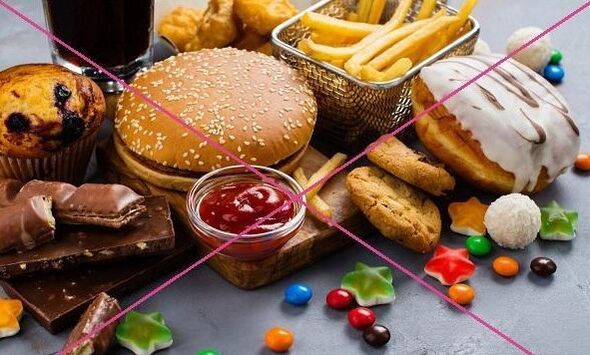Ketogenic diet (keto) is a very low carbohydrate diet that helps to burn fat. It has many advantages for weight loss and improved health, but also some side effects.

- The plus of the keto diet
- This is prohibited from keto diet
- How can I find out what you are in ketoss?
- Side effects of a diet and how to avoid it
Ketogenic diet resembles other strict carbohydrate diets such as Atkins or LCHF diet. These diets often end with ketogenic ketogen. The main difference between the strict LCHF and keto diet is that the protein is limited in the latter.
With ketosis, the body produces small fuel molecules, which are referred to as "ketones". This is an alternative fuel for the body.
Ketons are manufactured if they only eat very few carbohydrates (which are quickly divided into blood sugar) and a moderate amount of protein (protein surpluses can also be converted into blood sugar).
How can you lose weight in baby food?
Ketons are formed in the fatty liver. Then they are used as a fuel throughout the body, including the brain. The brain is an organ that consumes a lot of energy every day, and it cannot work directly on fat. He can only work on glucose or ketones.
In a ketogenic diet, your entire body changes from the supply of fuel with carbohydrates and works almost completely to fat. The insulin level becomes very low and fat burning increases significantly. The body can easily access your own fat reserves to burn them.
The plus of the keto diet
The advantages of a ketogenic diet are similar to every strict diet with low carbohydrates. However, the effect can be even higher because the protein is limited. Such a diet increases the keton level and reduces the insulin level.

- The burning of fat on keto diet increases significantly because insulin falls. This creates the ideal conditions under which weight loss can occur without hunger.
- About 20 scientific studies show that compared to other diets, carbohydrate arms and keto diets lead to a more effective weight loss.
- Ketosis leads to sustainable fuel intake (ketone) in the brain. And on a ketogenic diet, you avoid large fluctuations in blood sugar. This often leads to an increase in attention and increased concentration.
- Many people especially use a keto diet to increase intellectual performance. After a few days (up to a week), the keto adaptation, in which one person can change difficulties with concentration, headache, irritability and brain and can easily work on ketones.
- In a state of ketosis, many people experience more energy.
- Ketogenic diet can also increase your physical endurance considerably and enable you to access energy from your fat reserves.
- The supply of the body with carbohydrates (glycogen) is only sufficient for a few hours of intensive training or less. If that your fat reserves give enough energy for long and intensive classes.
This is prohibited from keto diet
The most important thing is that to achieve ketosis, you have to avoid using carbohydrates and ideally reduce consumption below 20 grams. The less carbohydrates, the more effective.
How can I find out what you are in ketoss?
Ketosis can be measured by testing urine, blood or breathing. But there are clear signs. Symptoms of ketosis: dry mouth, thirst, frequent urination.
Dry mouth and increased thirst. If you drink enough and have enough electrolytes, you can feel dry mouth. Try drinking a cup or two brews a day and drinking as much water as you need.
The increase in urination is another symptom of ketosis.

Keto drying due due-due-s ketone body, the smell of acetone appears from the mouth, the smell can also be "fruits" or resemble the smell of paint liquid. This smell is sometimes felt by sweat, all of this will pass for a short time and after a keto adaptation.
Other, less specific, but more positive characters are:
Reduce hunger - many people experience a noticeable breakdown of hunger. This can be caused by the body's increased ability to be fed by its fat reserves. Many people feel great, eat only once or twice a day, they can do regular fasting. This saves time and money and also accelerates weight loss.
An increase in energy - after a few days, a feeling of tiredness will pass and you will feel an increase in energy and performance.
How to achieve sustainable ketosis
- Limit carbohydrates up to 20 grams a day.
- Squirrel restriction to a moderate level. It is necessary to stay on a level or below 1 gram of protein per day per kg body weight. This is about 70 grams of protein a day if you weigh 70 kilograms.
- There is a sufficient amount of fat to feel full.
- Avoid snacks if you are not hungry. Unnecessary snacks slow weight loss and reduce ketosis.
If necessary, for example, you have to add a regular hunger for 16: 8 - 16 hours of hunger and 8 hours for food consumption. This is very effective to increase ketones.
Side effects of a diet and how to avoid it

In the initial stages of the transition to the keto mode, side effects can occur -this is referred to as a keto -flu. Symptoms such as fatigue, nausea, headache, cramps etc. occur. What needs to be done to prevent or relieve these symptoms:
- Drink water with salt and lemon - you also have to drink a cup of broth every day.
- Gradually reduce carbohydrate consumption - a sharp decrease leads to stronger symptoms
In the initial phase of a ketogenic diet, they lose water and thus electrolytes. This happens because carbohydrates delay water and salt in the body. So when you stop eating carbohydrates, your body loses this water.
When carbohydrates are suddenly removed from the diet, the brain takes time before learning to use ketone bodies for energy instead of sugar. This means that if you greatly reduce carbohydrates, you can get symptoms such as fatigue, nausea and headache. Reduce carbohydrate consumption for a week or more. The body will get used to burning fat and ketones instead of glucose, and the transition will occur easier and without symptoms.
































